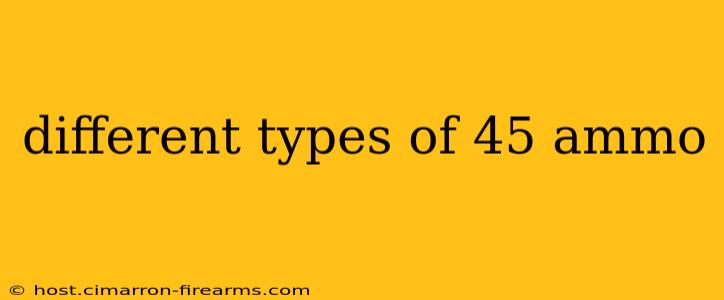The .45 ACP (Automatic Colt Pistol) cartridge, a legendary round in firearms history, boasts a rich variety of ammunition types, each designed for specific purposes. Understanding these differences is crucial for responsible gun ownership and optimal performance. This guide delves into the diverse world of .45 ammo, exploring its key characteristics and applications.
.45 ACP Ammunition Types: A Breakdown
The .45 ACP cartridge's versatility is reflected in its wide range of ammunition types. These variations primarily stem from differences in bullet design, weight, and powder load, impacting factors such as ballistic performance, stopping power, and recoil.
1. Full Metal Jacket (FMJ):
- Characteristics: FMJ rounds feature a lead core completely encased in a metal jacket, typically copper-plated. This design results in a relatively inexpensive, consistent, and reliable round. They are known for their penetration capabilities.
- Applications: Ideal for target practice and some forms of competition shooting. The full metal jacket minimizes expansion, making it less suitable for self-defense where immediate stopping power is paramount.
2. Hollow Point (HP):
- Characteristics: HP rounds feature a cavity or hollow point at the bullet's tip. Upon impact, this cavity expands, causing increased wound trauma and a higher likelihood of stopping the target.
- Applications: Primarily used for self-defense and law enforcement, where maximum stopping power and minimized overpenetration are critical. Different HP designs (e.g., JHP - Jacketed Hollow Point, SWCHP - Semi-Wadcutter Hollow Point) offer variations in expansion characteristics.
3. Jacketed Hollow Point (JHP):
- Characteristics: A sub-category of HP ammunition, JHP rounds combine the hollow point design with a metal jacket, ensuring consistent expansion while maintaining controlled recoil.
- Applications: Similar to HP rounds, JHPs are favoured for self-defense and law enforcement due to their reliability and effectiveness. Different manufacturers offer unique JHP designs optimized for various firearm platforms and calibers.
4. Semi-Wadcutter Hollow Point (SWCHP):
- Characteristics: SWCHP rounds combine the flat-nosed design of a wadcutter with a hollow point for expansion. This creates a balance between penetration and expansion, making it popular among both target shooters and self-defense enthusiasts.
- Applications: Offers good accuracy and reliable expansion, suitable for both target practice and self-defense situations. Less prone to keyholing (bullet tumbling) than some fully hollow-point rounds.
5. Wadcutters (WC):
- Characteristics: WC rounds have a flat, blunt nose designed to create a clean, precise cut in paper targets. They often produce excellent accuracy at shorter ranges.
- Applications: Primarily used in target shooting, particularly at shorter ranges. Their flat nose limits expansion, making them unsuitable for self-defense.
6. Ball Ammunition:
- Characteristics: Often used interchangeably with FMJ, "ball" refers to the round's shape—a full metal jacket with a rounded tip.
- Applications: Target practice and general shooting. Lower cost and consistent performance make ball ammunition a popular choice.
Choosing the Right .45 Ammo: Key Considerations
Selecting the appropriate .45 ACP ammunition depends entirely on its intended use. Factors to consider include:
- Intended Use: Target practice, self-defense, hunting (for smaller game), or competition shooting.
- Ballistic Performance: Penetration, expansion, and accuracy are crucial aspects to understand for each bullet type.
- Recoil: Heavier bullets generally produce greater recoil.
- Cost: Ammunition prices vary depending on the type and manufacturer.
- Reliability: Choosing reputable manufacturers guarantees consistent performance.
This guide provides a foundational understanding of the diverse world of .45 ACP ammunition. Remember to always consult your firearm's manual for recommended ammunition types and to prioritize safe gun handling practices. Further research and consultation with experienced shooters or firearms professionals are always recommended before making any purchasing decisions.

